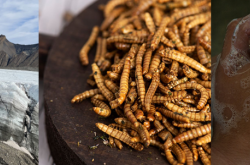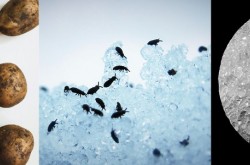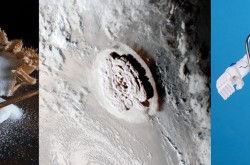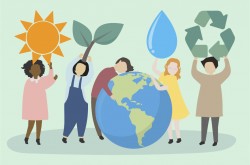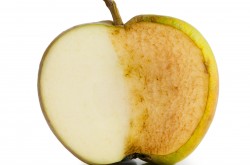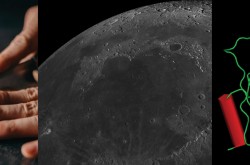3 things you should know about soil, Venus, and the black-footed ferret

Meet Renée-Claude Goulet, Cassandra Marion, and Michelle Campbell Mekarski.
They are Ingenium’s science advisors, providing expert scientific advice on key subjects relating to the Canada Agriculture and Food Museum, the Canada Aviation and Space Museum, and the Canada Science and Technology Museum.
In this colourful monthly blog series, Ingenium’s science advisors offer up three quirky nuggets related to their areas of expertise. For the April edition, they dig into soil erosion, our nearest planetary neighbor, Venus, and the plight of the black-footed ferret.

Heavy rains can cause fields to flood and soil to be eroded by draining water.
Sustainability starts with soil
In honour of National Soil Conservation Week (April 18–24), let’s get the dirt on soil erosion and why it’s so critical that we take action to curb it.
First, it’s important to note that soil takes thousands of years to form. During the formation process, it organizes into layers — each with distinct properties.
The top layer of soil — which we aptly refer to as “topsoil” — is typically only five to 20 cm deep. However, it's the most fertile layer; we depend on it for the vast majority of our food. It also hosts the activity of billions of organisms, which contribute to cycling nutrients and elements through air, water, and soil systems. In a nutshell, topsoil is the layer of soil that sustains life on Earth — and the one we are losing due to erosion.
Erosion is the process of soil particles being carried away or moved from their original location. Although wind and water are largely to blame, there is a third culprit: the way we work our soils. Tillage erosion occurs when farmers mix or move soil as they prepare fields for planting, plant seeds, manage their crops, and turn soil and crop residue over.
Why is losing soil to erosion such a big deal? It not only affects crop yields, but it also contributes to environmental pollution. When soil gets carried away into air and waterways, it can carry with it products from the farm — such as pesticides and fertilizers — and can deposit as sediment. This changes natural ecosystems and affects their functioning.
In Canada, the good news is erosion on farms has been on a decline since 1981, particularly in the Prairies (as shown by Agriculture and Agri-Food Canada Soil Erosion Risk Indicator). We can thank Canadian farmers for this trend; they have been adopting practises that reduce the risk of erosion, such as conservation tillage, no-till, and stopping the practise of leaving fields bare for a season (summerfallow).
While the risk of soil erosion has been reduced, what’s lost is lost. As of 2011, 74 per cent of Canadian farmland was deemed at low risk of erosion, meaning about a quarter of our farmland soil is still in danger of eroding away, further reducing sustainability and productivity. Erosion cannot be reversed, so soil hasn't exactly improved — but at least we're on a better path.
Solutions for the future include adapting practises specific to diverse lands and climates, restoring soil landscapes — through methods such as by returning soil that eroded down slopes back up to the top — and naturalizing zones around streams and ditches. What we know for certain is that erosion is an urgent problem, which will require research and innovation from many sectors in order to solve.
By Renée-Claude Goulet

A combination of radar images of the surface of Venus, the hottest planet in the solar system. The colour and brightness represent differences in surface features, not the actual colour of Venus.
Earth’s lethally hot sister planet: Venus is back in the spotlight
Our nearest planetary neighbour, Venus, is back in the media spotlight as scientists debate the tentative discovery of phosphine in her clouds. Phosphine — a gas made up of phosphorus and oxygen — is a potential biomarker for life, as it’s known to be produced by bacteria on Earth. But not all scientists are convinced…and confirmation would require a new mission to Venus.
Venus is Earth’s twin in size and chemistry, but otherwise they are nothing alike. Venus is an awesome, inhospitable world. The average surface temperature is a sweltering 465 degrees Celsius — comparable to a self-cleaning oven! Hence, any water Venus may have once had on the surface has long since boiled off. Its toxic atmosphere of carbon dioxide — a greenhouse gas — and sulfuric acid clouds is incredibly dense, with surface pressures 90 times that of Earth, equivalent to an ocean depth of one kilometre. The hurricane-force winds of the upper atmosphere tour the planet 60 times faster than the planet itself rotates. One long day on Venus is 243 days on Earth, rotating in the opposite direction. The chance of habitability improves in Venus’ upper cloud deck, 55 km up, where the pressure-temperature conditions are more tolerable.
Why so hot? Venus suffers from a runaway greenhouse effect due to its dense CO2 atmosphere, its lack of magnetic field to protect it from solar radiation, and a lack of plate tectonics to help recycle its carbon dioxide. Essentially, it is Earth’s global warming nightmare come true. These facts highlight why it’s so important we send more spacecraft to Venus: not only to confirm the presence of life in the clouds, but to understand why our sister planet is so different. This could help prevent our home planet, Earth, from falling victim to such a hot future.
In 1962, NASA’s Mariner 2 spacecraft was the first to encounter Venus. Decades ago, the Soviet Union’s Venera series spacecrafts were the firsts to soft land, return images from the surface, record sounds and launch balloon flights on another planet. Sadly, the landers only lasted two hours before their essential components melted. Not including fly-bys, NASA hasn’t been to back to Venus in 30 years since the Magellan spacecraft completed an amazing radar map of the planet’s surface. Magellan illustrated a landscape covered in volcanic plains, mountains up to 11 km high, and lava flows and channels up to 5,000 km long! Japan’s Akatsuki orbiter is the only spacecraft currently studying Venus.
There are currently several spacecraft in the planning pipeline for Venus from several nations, but none are guaranteed to fly. Engineers are currently working on heat-resistant electronics, as well as old-school, steampunk technology that may increase a lander’s surface life up to several months.
By Cassandra Marion
Bring in the clones: Saving the black-footed ferret
Black-footed ferrets are one of the rarest mammals in North America. So rare that they were thought to be extinct in the 70s! These long, slender predators primarily hunt prairie dogs across the North American prairies. However, as agriculture expanded during the twentieth century, farmers and ranchers began exterminating the prairie dogs that threatened their crops and their herds. Without prairie dogs to eat, the ferret population crashed to near extinction. In 1981, a small colony was discovered in Wyoming. From just seven breeding individuals, intensive conservation efforts were able to pull the species from the brink of extinction. Today, several hundred black-footed ferrets live in captivity and in the wild.
Even though the number of black-footed ferrets is slowly rising (thanks to continued conservation efforts), the fact that they all descend from seven individuals means they have low genetic diversity. Unfortunately for the ferrets — and other endangered animals with small populations — low genetic diversity can be a death blow. For example, if a population is exposed to a new disease, natural selection will favour individuals that have a resistance to that disease. If resistant individuals do not exist (because the correct genetic variation is absent), the population will not evolve and could be wiped out by the disease. This exact scenario happened to the black-footed ferrets in the 80s, when they were hit by the sylvatic plague and almost went extinct…again.
So how does a conservation scientist add more genetic diversity? Typically, by breeding individuals from distant populations. Since this was clearly not an option for the black-footed ferret, scientists had to go back in time.
The San Diego Zoo has a Frozen Zoo program which stores tissue samples from deceased animals at very low temperatures, in case their genetic material is ever needed. One such specimen was a black-footed ferret named Willa from the 80s, who was not one of the seven ancestors. Geneticists were able to take a nucleus (containing all of Willa’s DNA) from one of the frozen cells and transplant it into a modern ferret egg cell. The egg was implanted into a surrogate mother, where it gestated normally, and was born in December 2020. The result: a female black-footed ferret called Elizabeth Ann. In a sense, Willa and Elizabeth Ann are identical twins — born 30+ years apart.
If Elizabeth Ann reproduces, she will introduce an incredible amount of genetic diversity into the species and help ‘turn back the genetic clock.’ In doing so, she will help pave the way for the survival of her species, and give hope to other critically endangered species worldwide.
By Michelle Campbell Mekarski




















